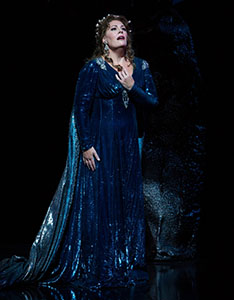San Francisco Opera celebrates the opening of its 92nd season on Friday, September 5 with a gala performance of Vincenzo Belliniís Norma, conducted by San Francisco Opera Music Director Nicola Luisotti and featuring an illustrious cast led by soprano Sondra Radvanovsky in the title role.

SF Opera
By Paul Duclos
Published: September, 2014
San Francisco Opera celebrates the opening of its 92nd season on Friday, September 5 with a gala performance of Vincenzo Bellini’s Norma, conducted by San Francisco Opera Music Director Nicola Luisotti and featuring an illustrious cast led by soprano Sondra Radvanovsky in the title role. The opening night festivities are highlighted by “Opera Ball 2014: Passione,” a benefit supporting the education programs of San Francisco Opera Guild and San Francisco Opera Education Department, and BRAVO! CLUB’s Opening Night Gala. Saturday, September 6 marks the long-awaited company premiere of Carlisle Floyd’s quintessentially American opera Susannah, starring Patricia Racette. Concluding the opening weekend of the 2014-15 Season is one of the Bay Area’s most popular musical events––San Francisco Chronicle Presents Opera in the Park, San Francisco Opera’s annual free concert in Golden Gate Park on Sunday, September 7. For more info, see sfopera.com.
Music Director Michael Tilson Thomas and the San Francisco Symphony are joined by guest organist Cameron Carpenter for four performances of Henry Brant’s Pulitzer Prize-winning Ice Field, September 18-21 at Davies Symphony Hall. The Orchestra also performs Bach’s Brandenburg Concerto No. 3 and Tchaikovsky’s Symphony No. 5 in these concerts. Ice Field has not been performed in San Francisco since its world premiere by MTT and the SFS in December 2001, with the composer at the organ. Brant won a Pulitzer Prize for the work the following year in 2002. Henry Brant’s Ice Field is one of the more than 20 American works featured in the SFS’s 2014-15 season, Michael Tilson Thomas’s 20th as music director.
The full title of the piece, Ice Field: Spatial Narratives for Large and Small Orchestral Groups, indicates the nature of Brant’s “spatial” approach to composition. Ice Field was commissioned for the SFS by Other Minds, a San Francisco-based new music organization founded by composer Charles Amirkhanian. For Brant, “space”—created by the location of the instruments in the hall—is a crucial compositional element. Ice Field was devised to use the expressive spatial possibilities of Davies Symphony Hall, dividing the orchestra into various groups and positioning them in the organ loft, second tier, on stage and in the side boxes, thus creating a multi-directional aspect to the sound for the listener. He also uses elements of improvisation in the composition. Of his spatial technique, Brant has said, “I had come to feel that single-style music, no matter how experimental or full of variety, could no longer evoke the new stresses, layered insanities and multi-directional assaults of contemporary life on the spirit.” In his spatial music he found a solution that he believed would “speak more expressively of the human predicament.” For more info, see www.sfsymphony.org.
A sold-out smash hit at New York’s Signature Theatre last year, Old Hats combines the incomparable magic, slapstick and hilarity of master clowns Bill Irwin and David Shiner with technology, original music and their truly unique style of movement. Directed by the inimitable Tina Landau, whose production of Saroyan’s The Time of Your Life thrilled A.C.T. audiences in 2004, Old Hats picks up where Fool Moon left off, and is a wildly imaginative journey about the anxieties of living in the modern world and an exquisite and hilarious meditation on life, lunacy and the passage of time. It is the recipient of the 2013 Lucille Lortel Award for Outstanding Alternative Theatrical Experience and the 2013 Drama Desk Award for Outstanding Revue. The show runs from September 10 to October 5. For more info, see www.act-sf.org.
This Month’s Recipe:
The Champagne Cocktail
Champagne should almost always be served in a coupe, that classic piece of glassware made popular in San Francisco during Prohibition days—when the good stuff could be swilled rather than sipped.
But the vulgar vessel—and coupe’s second cousin—known as the flute does have one purpose: to deliver the sublime ingredients contained in the champagne cocktail. And since it really is just a bar drink, one needn’t go all out to purchase the finest French wine. Any old sparkling will do.
Don’t however, skimp on the bitters or brandy. Use premium brands only. And any Manhattan lover will attest to the superiority of Luxardo when it comes to Maraschino cherries.
1. Soak the sugar cube in the bottom of the glass with brandy and bitters.
2. Add cherry
3. Gently pour Champagne
4. Eschew any other type of garnish

